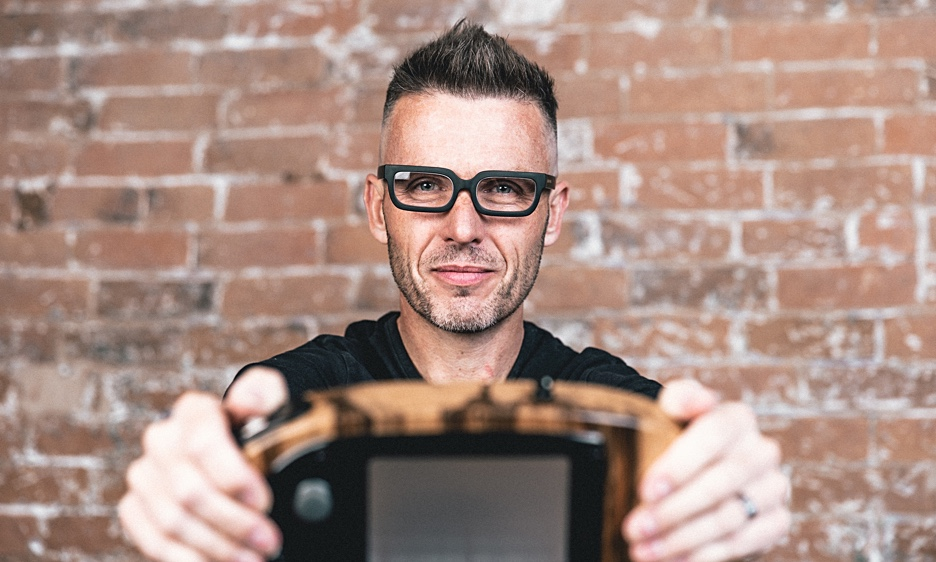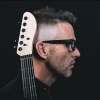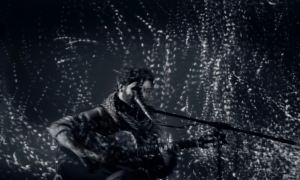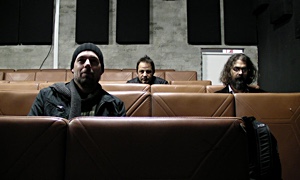Home » Jazz Articles » Forests of Sound » Jonathan Crossley And The Chase Of Sound
Jonathan Crossley And The Chase Of Sound

Opening track 'Bounce' is a whopper, worthy of the price of admission itself. A merrily schizophrenic assault that sounds almost like The Bad Plus with guitars it works with what sounds like quantum rhythms gleefully toyed with by the here superlative Sweetman, who chews up the scenery.
Opening track "Bounce" is a whopper, worthy of the price of admission itself. A merrily schizophrenic assault that sounds almost like The Bad Plus with guitars it works with what sounds like quantum rhythms gleefully toyed with by the here superlative Sweetman, who chews up the scenery. Also see later track "In the spring" with its telling pun, for some straight Math Rock delight.
Title track "Inhale" is one of three eight-minute epics on the album and features some nice straight-ahead rock riffs before entering a kind of irreal rhythmic realm all tightly lopsided yet building to some unpredictable yet inevitable climax. There's a blissful interruption of voice and strings and then we're on some sinister but slamming dancefloor followed by an uber lead by Crossley, and things go sci-fi before settling into soothing space via the coda.
Elsewhere there are rich string arrangements that to my ears lean into traditional Jewish and Gypsy influences [Note: Crossley clarifies this below.] Electronic elements are on first listen nearly imperceptible—one's focus captured by the side-stepping grooves of guitar and drums, and when it arrives, Carlo Mombelli's sinuous bass slinking into the moonlight with his instantly recognizable sound—the electronic elements are very present though, but gently augment rather than overshadow or distract from compositions.
There are only a few "lead guitar" moments on the album, and in all of them one can almost feel Crossley's abhorrence of shredding and the whole the-faster-the-better shpiel, focusing on shifting rhythms and texture instead. A lovely album, and one which, through tracks "Hymn," "There is no invasion" and "Breathe deep," "Operation one" and "Operation two," pay instrumental tribute to the invasion of Ukraine. Instrumental political commentary---no mean feat.
All About Jazz: To say that you're a guitar enthusiast, and champion of the future of the guitar via interfaces and augmentation, is an understatement. Tell us about the guitars as featured on Inhale.
Jonathan Crossley: That is an interesting remark and question—I guess I am a champion of "using" the guitar rather than a champion of the guitar per se. I have always loved orchestral music, early electronic music (Jean-Michel Jarre, Tangerine Dream and Vangelis) and even progressive rock. As such, trying to find ways of making the guitar expansive and textural (alongside clear and defined) has been the overall goal rather than, for instance, say shredding or indulgent post-bop extemporizations. So, interfaces and augmentations were always pursued with this goal in mind— how to create textural width and space.
AAJ: Tell us about your trio.
JC: Mombelli and I share [legendary South African guitarist] Johnny Fourie in common, and as such there are some interesting musical germs, maybe genes if you take the time to listen carefully. I was also always into chamber jazz and third-stream music since I was young, and we share this love in common. We have played for and with each other in various ensembles over the years, but for me the son0_morph:01 Trio record from 2020/21 was a real breakthrough— being vulnerable for a moment; maybe I needed to come to terms with some stylistic pressures in my own work to allow us all to converse more freely? I first met or maybe even "found'" Jonno in 2006 when I visited Knysna for a day trip whilst performing at the KKNK festival with Karin Hougaard. Jonno was playing outside the Clicks Pharmacy in downtown Knysna with a little jazz quartet, he really had something special even all those years ago, and I made plans to record and perform with him the following year. That led to us rehearsing and recording the album Funk for the Shaolin Monk, under the band name The Jonathan Crossley Electric Band. I still dig this record, (it's on all streaming), and although youthful it still has some very happy moments. Jonno has been a loyal collaborator through many projects since then, he has played with Carlo for some years, and I am blessed to have had him both pushing for this trio's realisation, and playing in it.
AAJ: The electronica featured on Inhale is very... unobtrusive, almost camouflaged, just complementing certain passages. What are your feelings about electronica, and who are some of your main influences?
JC: Electronica has been a huge part of my life, I guess emerging from orchestral classical music as a first love—I guess it is hard to explain why it took so long to come to the fore in my recorded work, other than maybe the systems that could do so. When I was a kid, I listened obsessively to Tangerine Dream's classic albums Phaedra and Stratos, and as a young adult I discovered the Warp label and have followed them since. I loved early Aphex Twin, the first Future Sound of London albums, and still consume Autechre and Squarepusher all the time. In the past year I have been loving Iglooghost, Oneotrixpointnever, Ryuichi Sakomoto's collaborations with Alava Noto and of course listening to and going to exhibitions of Ryoji Ikeda's immersive works. I think if you read the above list, it will explain or answer your question in some ways: These are not banging techno artists or dance floor-themed composers, but rather artists that treat electronica in an ephemeral way, at the border of electronic sounds that are noisy, glitchy or soundscapes that could quite easily be imagined as Xenakis, Ligeti or other classical greats. There are also new guitarists that are exploring these liminal boundaries as well, such as Eivind Aarset, Dan Phelps and David Kollar, and lastly the great new works of classical crossover composers such as Anna Meredith and Clark (specifically his Playground in a Lake).
AAJ: What music influenced the string arrangements? They're very mournful yet have (to this untrained ear) the occasional swell of gypsy or traditional Jewish music.
JC: The traditional influence one hears comes from the harmonic minor and Phrygian dominant scales—these were selected as the music was inspired and written around the time of the invasion of Ukraine, hence some of the various titles as well. All the string arrangements themselves were masterfully realized by the young South African composer Nick Horsten, a new name to watch out for! Mournful-wise; well a lot of what I play, and prefer to play, tends to be mournful, even long ago when I played exclusively classical guitar repertoire. I love this type of music and I think true musical artistry inhabits a space which should draw us all into a deep sense of introspection and fragility, as such is life.
< Previous
Jazz Is Dead 16
Comments
About Jonathan Crossley
Instrument: Guitar
Related Articles | Concerts | Albums | Photos | Similar ToTags
Jonathan Crossley
Album Review
Mick Raubenheimer
Inhale
Self Produced
Jonathan Sweetman
Carlo Mombelli
For the Love of Jazz
 All About Jazz has been a pillar of jazz since 1995, championing it as an art form and, more importantly, supporting the musicians who create it. Our enduring commitment has made "AAJ" one of the most culturally important websites of its kind, read by hundreds of thousands of fans, musicians and industry figures every month.
All About Jazz has been a pillar of jazz since 1995, championing it as an art form and, more importantly, supporting the musicians who create it. Our enduring commitment has made "AAJ" one of the most culturally important websites of its kind, read by hundreds of thousands of fans, musicians and industry figures every month.























